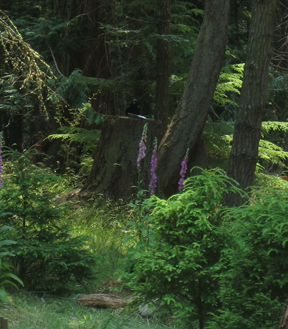
Perhaps you have discovered that one of the first things that changes when you start painting and/or drawing is how you see things, how much more you are seeing! This summer while you are spending more time out of doors, PRACTICE SEEING the way a artist looks and sees. An artist does look and see differently. You can learn it faster when you really think about it.
 SLOW DOWN AND LOOK!
SLOW DOWN AND LOOK!
You live in a culture of labelers. We stick a label on it and are done – doctor, lawyer, tree hugger, terrorist. Too often we don’t get past the word.That’s a geranium! That’s a rose! And most stop looking. But could they draw a geranium or a rose afterward? You need slower looking.
When I used to take people to Greece they would ask the names of the Greek flowers. I told them they would forget the names (since they were Greek). Why not notice the blue-purple color and how it changes to pink toward the center; notice how the petals curved away from the center, how long the stamen was. Notice how the flower grew out of a crevasse in an ancient stone wall. Notice how it cast its shadow on the wall. There is the memory. Not in the name.

BE QUIET AND JUST LOOK!
I suggest you go and sit somewhere and start — maybe some place like the hammock shown above! Comfortable?Now run your eye along the edge of a tree trunk, up and out the branch. Notice how the leaves group themselves. Notice how the colors are different — in the leaves; in the trunk and branches. See how many colors you can identify.
You can do the same thing with the way people are sitting in a coffee shop. Or the random arrangement of dishes on your table after a meal. Just sit and run your eye along a shape and then another. Don’t draw. Don’t photograph it. Just be quiet and take it in until it is yours.

LEARN TO LOOK COMPARATIVELY
How light or dark is something? How light or dark is it, compared to something else? For example, this orange isn’t just orange.
- Where is it lighter than orange?
- Where is it darker?
- Where is it more yellow? More orange? More red? White? Do you see some green? ? Most orange? Dull?
- Is the whitest white on the window sill or on the orange?
- Do you see any orange in the shadow side of the window sill?
Try a corner of the room you are in.
- What is darker — the ceiling? The left wall? The right? Which is lightest?
- Which is cooler? Which is warmer?
- Run your eye along the wall. Is it lighter on the top or the bottom? Cooler or warmer?
Can’t tell? Here is a trick: stare at one section of the wall. Suck the color and the value into your eyes. Then QUICKLY!! look to another section. Quick! — which was lighter or darker? Which was cooler or warmer? What color was in the one that wasn’t in the other? You eye holds the memory of the earlier saturation and you can tell.
 Now go out and look at the underside of branches. Do you see the colors of the ground bouncing up into them? Paint them that way! Look at the colors in the shadows. How does one compare to the next? Which is bluer? Which has orange in it? Are there places the sun is eating away at the color? Leave the paper white. Here is an unfinished painting where I am slowing down and looking. ( It is actually finished but my camera has just died on me. I’ll post the finished one later :-))
Now go out and look at the underside of branches. Do you see the colors of the ground bouncing up into them? Paint them that way! Look at the colors in the shadows. How does one compare to the next? Which is bluer? Which has orange in it? Are there places the sun is eating away at the color? Leave the paper white. Here is an unfinished painting where I am slowing down and looking. ( It is actually finished but my camera has just died on me. I’ll post the finished one later :-))

Madronas on the Cliff
Slow down and look. The name doesn’t matter. It’s the color, the value, and the shape relationships that matter. Make this a summer of looking. You’ll never stop!
©2009 Caroline Buchanan
